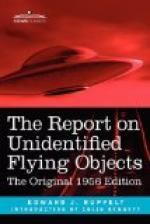The cap was sent to a laboratory in Washington, D.C., along with the scoutmaster’s story. Our question here was, “Does the cap in any way (burns, chemicals, etc.) substantiate or refute the story?”
I thought that we’d collected all the items that could be analyzed in a lab until somebody thought of one I’d missed, the most obvious of them all—soil and grass samples from under the spot where the UFO had hovered. We’d had samples, but in the last-minute rush to get back to Dayton they had been left in Florida. I called Florida and they were shipped to Dayton and turned over to an agronomy lab for analysis.
By the end of the week I received a report on our ex-Marine’s military and reformatory records. They confirmed a few suspicions and added new facts. They were not complimentary. The discrepancy between what we’d heard about the scoutmaster while we were in Florida and the records was considered a major factor. I decided that we should go back to Florida and try to resolve this discrepancy.
Since it was hurricane season, we had to wait a few days, then sneak back between two hurricanes. We contacted a dozen people in the city where the scoutmaster lived. All of them had known him for some time. We traced him from his early boyhood to the time of the sighting. To be sure that the people we talked to were reliable, we checked on them. The specific things we found out cannot be told since they were given to us in confidence, but we were convinced that the whole incident was a hoax.
We didn’t talk to the scoutmaster again but we did talk to all the boy scouts one night at their scout meeting, and they retold how they had seen their scoutmaster knocked down by the ball of fire. The night before, we had gone out to the area of the sighting and, under approximately the same lighting conditions as existed on the night of the sighting, had re-enacted the scene—especially the part where the boy scouts saw their scoutmaster fall, covered with red fire. We found that not even by standing on top of the car could you see a person silhouetted in the clearing where the scoutmaster supposedly fell. The rest of their stories fell apart to some extent too. They were not as positive of details as they had been previously.
When we returned to Dayton, the report on the cap had come back. The pattern of the scorch showed that the hat was flat when it was scorched, but the burned holes—the lab found some minute holes we had missed—had very probably been made by an electrical spark. This was all the lab could find.
During our previous visit we repeatedly asked the question, “Was the hat burned before you went into the woods?” and, “Had the cap been ironed?” We had received the same answers each time: “The hat was not burned because we [the boy scouts] were playing with it at the scout meeting and would have noticed the burns,” and, “The cap was new; it had not been washed or ironed.” It is rumored that the cap was never returned because it was proof of the authenticity of the sighting. The hat wasn’t returned simply because the scoutmaster said that he didn’t want it back. No secrets, no intrigue; it’s as simple as that.




